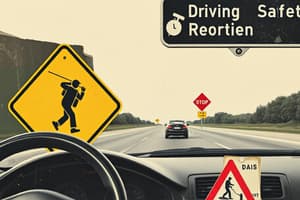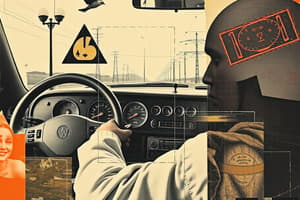Podcast
Questions and Answers
Name 3 major factors that can contribute to the degree of risk you encounter while driving.
Name 3 major factors that can contribute to the degree of risk you encounter while driving.
The Driver, The Vehicle and The Roadway or Environment
Name four steps of the IPDE Process.
Name four steps of the IPDE Process.
Identify, Predict, Decide, Execute
List the five rules of the Smith System.
List the five rules of the Smith System.
Aim high in steering, Keep your eyes moving, Get the big picture, Make sure others see you, Leave yourself an 'out'
Explain the structure of the Zone Control System.
Explain the structure of the Zone Control System.
What is the location of each of the six zones of the Zone Control System?
What is the location of each of the six zones of the Zone Control System?
What does 'open zone' mean?
What does 'open zone' mean?
What does 'closed zone' mean?
What does 'closed zone' mean?
How do you use an orderly visual search pattern?
How do you use an orderly visual search pattern?
How can knowledge and experience help you make accurate predictions?
How can knowledge and experience help you make accurate predictions?
What three decisions must be made when applying IPDE?
What three decisions must be made when applying IPDE?
What are the three different positions available to you within your lane?
What are the three different positions available to you within your lane?
How do you minimize a hazard?
How do you minimize a hazard?
How do you separate a hazard?
How do you separate a hazard?
How do you compromise space?
How do you compromise space?
What are the three most important actions you can take to avoid conflict?
What are the three most important actions you can take to avoid conflict?
What does 'commentary driving' mean?
What does 'commentary driving' mean?
When is it appropriate to use IPDE selectively?
When is it appropriate to use IPDE selectively?
Why does the IPDE process take time?
Why does the IPDE process take time?
What is the target area?
What is the target area?
What is the target area range?
What is the target area range?
What is the 4-6 second range?
What is the 4-6 second range?
What is the 12-15 second range?
What is the 12-15 second range?
What is an orderly visual search pattern?
What is an orderly visual search pattern?
What is the field of vision?
What is the field of vision?
What is central vision?
What is central vision?
What is peripheral vision?
What is peripheral vision?
What does it mean to 'aim high' in steering?
What does it mean to 'aim high' in steering?
What is 'scanning'?
What is 'scanning'?
What is 'ground viewing'?
What is 'ground viewing'?
Flashcards are hidden until you start studying
Study Notes
Driving Risk Factors
- Major factors include the driver, the vehicle, and the roadway/environment.
IPDE Process
- The four steps: Identify, Predict, Decide, Execute.
Smith System Rules
- Drive safely by aiming high in steering, keeping your eyes moving, grasping the big picture, ensuring visibility for others, and leaving an "out."
Zone Control System Structure
- Use the steps: see a zone change, check other zones, and create time and space with speed control, lane position, and communication.
Zones of Zone Control System
- Six key zones: front, left front, right front, left rear, right rear, and rear zone.
Open and Closed Zones
- "Open zone": space available for driving without restrictions.
- "Closed zone": restricted space affecting line of sight or intended path.
Visual Search Pattern
- Utilize a systematic approach to search for clues around your path, incorporating short glances instead of staring.
Knowledge and Experience
- Driving experience enhances memory and prediction accuracy, improving decision-making.
IPDE Decisions
- Three critical decisions involve changing speed, direction, and communication.
Lane Positions
- Three possible positions within a lane: centered, 3-6 inches from the left, and 3-6 inches from the right.
Hazard Management
- Minimize a hazard by increasing distance, separate hazards by adjusting speed, and compromise space by giving more to the greater hazard.
Avoiding Conflict
- Essential actions: control speed, steer appropriately, and communicate effectively.
Commentary Driving
- Involves articulating thoughts while driving, promoting awareness.
Selective IPDE Use
- Apply the IPDE process selectively when conditions change in zones.
Time Required for IPDE
- The process requires time to identify clues, predict actions, and recognize potential closed zones.
Target Area
- Defined as the section of the roadway containing the target within the intended path.
Target Area Range
- The distance from your vehicle to the target area.
Time Ranges
- 4-6 second range: distance traveled in the next 4-6 seconds.
- 12-15 second range: distance traveled in the next 12-15 seconds.
Visual Search Patterns
- An orderly search pattern is essential for consistently checking critical areas.
Field of Vision
- Refers to the observable area around a driver while looking straight ahead.
Central and Peripheral Vision
- Central vision: a focused view up to 10 degrees.
- Peripheral vision: the area visible to the sides, also known as side vision.
Aiming High in Steering
- Looking 12-15 seconds ahead into your target area while driving.
Scanning
- Involves quick, continual glances for brief focus during a visual search.
Ground Viewing
- Refers to making brief glances at the road directly ahead of the vehicle.
Studying That Suits You
Use AI to generate personalized quizzes and flashcards to suit your learning preferences.




